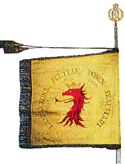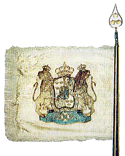

Copyright © Hans Högman 2019-05-20
Swedish Regiments of the
Allotment System - Cavalry (2)
Cavalry Regiments:
2. Swedish Regiments -
Cavalry (2)

Swedish name: Norra Skånska
Kavalleriregementet, K5
The regiment was first established
1658 as the Scanian Cavalry
Regiment (Skånska
kavalleriregementet). The regiment
was attached to the Allotment
System in 1680.
The regiment received the name Mounted North
Scanian Regiment (Norra Skånska regementet till häst)
in 1676. When linked to the Allotment System they
received the name North Scanian Cavalry
Regiment (Norra Skånska kavalleriregementet, K5) in
1682.
In 1801 the name was changed to Scanian Dragoon
Regiment of the Line (Skånska linjedragonregementet)
and in 1807 Scanian Hussar Regiment (Skånska
husarregementet).
In 1893 the regiment was reorganized into an
enlisted regiment.
The regiment was disestablished in 1927.
The regiment's history goes back to the Lybeck’s
Scanian Horsemen (Lybeckers Skånska ryttare)
established in the county Kristianstad and
Hälsingborg in 1658. Two years later, four of the
companies were transferred to the Bohus-Jämtland
Cavalry Squadron (Bohus-Jämtlands
kavalleriskvadron) in the province of Jämtland.
The regiment was allotted with 1000 "rusthåll".
Hence, the regiment had 1000 cavalrymen and
formed 8 squadrons. All of the "rusthåll" was in the
northern and western parts of province of Skåne
(542 in the county of Malmöhus, 458 in the county of
Kristianstad).
Names of the Squadrons making up the
Regiment: The Life Squadron, The Lieutenant
Colonel's Squadron, The Major's Squadron, Sanby
Squadron, Billesholms Squadron, Landskrona
Squadron, Bjäre härads Squadron, Månstorps
Squadron.
In 1833 the regiment was reorganized into 10
squadrons.
Location of the primary Garrison of the
Regiment: From 1897 Helsingborg.
Training camp: From 1690 Ljungbyhed.
Squadrons 1833:
1.
Life Squadron
2.
Sandby Squadron
3.
Kolleberga Squadron
4.
Sillfråka Squadron
5.
Bjäre Härads Squadron
6.
Fleninge Squadron
7.
Fjerresta Squadron
8.
Landskrona Squadron
9.
Hoby Squadron
10.
Arrie Squadron
Victorious Battle Campaigns (segernamn):
1.
Landskrona
1677
2.
Pultusk
1703
3.
Posen
1704
4.
Fraustadt
1706
Swedish name: Södra Skånska
Kavalleriregementet, K6
The regiment was first established
1676 as the Blekinge Mounted
Regiment (Blekingska regementet till
häst). The regiment was attached to
the Allotment System in 1680.
Blekinge Mounted Regiment was an
enlisted regiment established in the county of
Kronoberg. When the regiment was linked to the
Allotment System in 1680 it was reorganized into an
allotted regiment in the province of Skåne. The
regiment then received the name South Scanian
Cavalry Regiment (Södra Skånska
kavalleriregementet, K6). In 1770 the regiment
recieved the name Prince Carl's South Scanian Cavalry
Regiment (Prins Carls södra Skånska
kavalleriregementet) and in 1805 Scanian Carabineer
Regiment (Skånska karabinjärregementet) and finally
in 1822 Scanian Dragoon Regiment (Skånska
dragonregementet).
In 1893 the regiment was reorganized into an
enlisted regiment.
The regiment was disestablished in 1927.
The regiment was allotted with 1000 "rusthåll".
Hence, the regiment had 1000 cavalrymen and
formed 8 squadrons. All of the "rusthåll" were
located in the eastern and southern parts of province
of Skåne (510 in the county of Malmöhus, 490 in the
county of Kristianstad).
Names of the Squadrons making up the
Regiment: Life Squadron, Lieutenant Colonel's
Squadron, Major's Squadron, Svaneholm Squadron,
Borrby Squadron, Sallerup Squadron, Östra Göinge
Squadron and Haglösa Squadron.
In 1833 the regiment was reorganized into 10
squadrons. The regiment (K6) was at the time the
largest cavalry regiment based in a single location.
Location of the primary Garrison of the
Regiment: From 1882 Ystad.
Training camp: Från 1690 Ljungbyhed.
Squadrons 1833:
1.
Life Squadron
2.
Östra Göinge Squadron
3.
Kristianstads Squadron
4.
Sallerups Squadron
5.
Torna Squadron
6.
Malmö Squadron
7.
Haglösa Squadron
8.
Vemmenhögs Squadron
9.
Borrby Squadron
10.
Simrishamns Squadron
Victorious Battle Campaigns (segernamn):
1.
Kliszów
1702
2.
Punitz
1702
Swedish name: Kronprinsens
Husarregemente, K7
The regiment was first established in
1758 as the Swedish Hussar
Regiment (Svenska husarregementet).
The regiment was an enlisted
regiment.
The regiment received the name Mörner Hussar
Regiment (Mörnerska husaregementet) in 1766. In
1816 the regiment received the name Cederström
Hussar Regiment (Cederströmska husarregementet)
and in 1822 Crown Prince’s Hussar Regiment
(Kronprinsens husarregemente).
In 1859 the regiment carried the name Crown Prince’s
Enlisted Hussar Regiment (Kronprinsens värvade
husarregemente, K7) and in 1860 Hussar Regiment
King Carl XV (Husarregementet Konung Carl XV) and
in 1882 once again Crown Prince’s Hussar Regiment
(Kronprinsens husarregemente, K7).
The regiment was disestablished in 1927.
The Crown Prince’s Hussar Regiment (K7) was the
only regiment not being Royal; this was the Crown
Prince’s regiment.
Location of the primary Garrison of the
Regiment: From 1812 Ystad, Ängelholm, Helsingborg
and Malmö.
Training Camp: From 1772 Bonarps hed,
Ljungbyhed.
Swedish name: Norrlands
Dragonregemente, K8 (Jämtlands
hästjägarkår)
The regiment was first established in 1646 as the
Ångermanland, Medelpad and Jämtland
Regiment (Ångermanlands, Medelpads och
Jämtlands regemente). The regiment was linked to
the Allotment System in 1689.
In 1670 the Ångermanland-, Medelpad- and Jämtland
Regiment was merged with the new Jämtland
Infantry Regiment (Jämtlands regemente till fots).
The mounted unit received the name Jämtland
Cavalry Company of the Jämtland Regiment of Foot
(Jämtlands kavallerikompani ingående i Jämtlands
regemente till fots).
In 1661 two companies of the Bohuslän-Jämtland
Cavalry Squadron (Bohusläns-Jämtlands
kavalleriskvadron) plus two companies of the Skåne-
Bohuslän-Jämtland dragoon Regiment (Skåne-
Bohusläns-Jämtlands dragonregemente) linked to
the Allotment System and quartered in the province
of Bohuslän respectively in Jämtland.
The two companies in Jämtland were transferred to
the Jämtland Cavalry Company in 1675.
In 1689 when the regiment was linked to the
Allotment System, the regiment received the name
Jämtland Dragon Regiment (Jämtlands
dragonregemente). However, this regiment wasn't
mounted except for the Cavalry Company. The
dragoon regiment received the name Jämtland Rifle
Regiment in 1820.
The Cavalry Company became known as Jämtland
Mounted Rifle Company (Jämtlands
hästjägarkompani).
For information on the dragoon regiment, see
Jämtland Rifle Regiment.
The Mounted Rifle Company received the name
Jämtland Mounted Rifle Squadron (Jämtlands
hästjägarskvadron) in 1802 and in 1843 Jämtland
Mounted Rifle Corps (Jämtlands hästjägarkår). The
Mounted Rifle Corps was separated from the
Jämtland Rifle Regiment in 1853 and formed an
independent unit.
The Mounted Rifle Corps was reorganized into an
enlisted regiment in 1892 and was named Norrland
Dragoon Regiment (Norrlands dragonregemente, K8).
At this time the regiment moved from Jämtland to
the city of Umeå in the province of Västerbotten.
In 1927 Norrland Dragoon Regiment was merged with
Crown Prince's Hussar regiment and the new regiment
received the name the Norrland Dragoon
Regiment, K4.
In 1958 they carried the name Norrland Dragoons
(Norrlands dragoner) and in 1980 once again
Norrland Dragoon Regiment.
The Jämtland Cavalry Company was allotted in the
same way as other cavalry; that is with "rusthåll". The
Jämtland Dragoon Regiment was allotted with" rote"-
farmers like in the Infantry.
The Cavalry Company had 100 cavalrymen. The 100
"rusthåll" of the company was located within the
province of Jämtland.
In 1830 a second squadron was established with the
same number of cavalrymen.
In total the Jämtland Mounted Rifle Corps numbered
200 cavalrymen.
Location of the primary Garrison of the
Regiment: from 1900 Umeå, from 1980 Arvidsjaur.
Training Camp: Frösö läger, Östersund.
Squadrons 1833:
1.
Life Squadron
2.
Alsens Squadron
Remounting
By remounting we mean the process of supplying
horses for the Armed Forces. The term remount
means an acquired young horse; a horse not yet
trained.
In the 1880's the Crown took charge of the
remounting for the mounted enlisted regiments and
for the harnessed regiments. An example of
harnessed regiments are the artillery regiments.
A special remounting commission was established in
1883. In 1886 the commission received the name
Remounting Board (Remonteringsstyrelsen). At the
end of the Allotment System, also the horses
provided by the "rusthåll" was handed over to the
Remounting Board.
In order to handle all horses a number Remounting
Depots was established in 1885.
A lot of young horses was annually bought by a
special committee and was sent to the remount
depots for training. After one year of training at the
depots the horses were sent to the regiments for a
further one year of training.
The horses were, as the soldiers, registered in
general muster rolls.
Remount Depots:
•
Björnö, Kalmar: 1904 - 1924
•
Flyinge, Lund. From 1685 until the end of the
1800's: Government stud-farm and stallion
depot. Reestablished 1922.
•
Frösön, Östersund: 1909 - 1926.
•
Gustafslund, Helsingborg 1888 - 1895
•
Ottenby, Öland. 1831 - 1894 Government stud-
farm, from 1894 remount depot.
•
Strömsholm, Köping. 1520's - 1872 Government
stud-farm, 1868 - 1970 Army Horse School
(Ridskolan, RS), 1872 - 1956 stallion depot, 1885 -
1895? remount depot.
•
Utnäslöt, Strömsholm, 1902 - 1926, 1941 - 1957
remount depot.
Related Links
•
The Allotment System
•
Swedish Wars
•
The Navy & the Army Fleet
•
Swedish Military Unit Designations
•
Swedish Military Branch and Unit Insignias
•
Uniforms of the Swedish Army
•
Source References
Top of page



South Scanian Cavalry Regiment, K6
North Scanian Cavalry Regiment, K5
Norrland Dragoon Regiment, K8
Crown Prince's Hussar Regiment, K7
Remounting


























